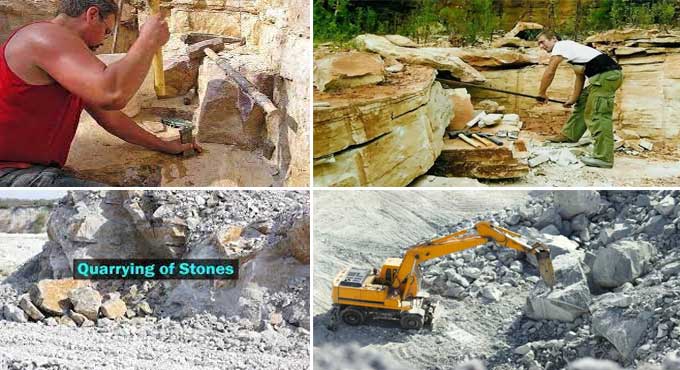
Quarrying of Stone: What are they, how are they done, and uses in construction?

What do you mean by Quarrying of Stones?
Quarrying of stones refers to the process of extracting natural rocks or stones from the earth's crust for various construction purposes. These stones, also known as dimension stones, are typically used for building structures, such as houses, bridges, roads, monuments, and other architectural projects.
The quarrying process involves locating a suitable stone deposit or quarry site and then removing the desired stones from the ground. Here are the main steps involved in the quarrying of stones:
1. Exploration: The process begins with a thorough survey of an area to identify potential stone deposits. Geologists and surveyors assess the quality, quantity, and accessibility of the stones.
2. Clearing the site: Once a suitable site is identified, the vegetation, soil, and other debris are cleared to expose the underlying rock formations.
3. Drilling and blasting: To extract large blocks or masses of stones, holes are drilled into the rock using specialized machinery. Explosives are then placed in the holes and detonated to break the rock into smaller, manageable pieces. Controlled blasting techniques are employed to minimize damage to the stone and surrounding environment.
4. Extraction: After the blasting, the broken rock fragments, known as rubble, are loaded onto trucks or conveyors for transportation out of the quarry. Heavy machinery, such as excavators, loaders, and dump trucks, is commonly used for this purpose.
5. Stone processing: Once the stones are extracted, they may undergo further processing to achieve the desired size, shape, and finish. This can involve cutting, shaping, polishing, and other techniques, depending on the intended use of the stones.
6. Transportation and distribution: The processed stones are then transported to construction sites or distribution centres, where they are used for various applications, including construction, landscaping, and decoration.
What are some considerations for quarrying of stones?
When undertaking the quarrying of stones, several considerations need to be taken into account to ensure the process is efficient, safe, and environmentally responsible. Here are some key considerations:
1. Geological survey: Conduct a detailed geological survey of the quarry site to determine the quality, quantity, and suitability of the stone deposits. This information helps in planning the extraction process and estimating the economic viability of the quarry.
2. Environmental impact assessment: Assess the potential environmental impacts of the quarrying activities, including habitat destruction, soil erosion, water pollution, and air pollution. Develop strategies to mitigate these impacts and comply with environmental regulations.
3. Safety measures: Implement strict safety protocols to protect workers and minimize accidents. This includes providing appropriate personal protective equipment (PPE), ensuring proper training for employees, and maintaining machinery and equipment in good working condition.
4. Blasting techniques: Employ controlled blasting techniques to minimize the impact on the stone and surrounding environment. This involves precise drilling, proper placement of explosives, and careful timing of detonations to reduce vibrations and flyrock.
5. Waste management: Develop effective waste management practices to handle the debris generated during the quarrying process. This may involve recycling or reusing the waste materials, such as crushed stone for aggregate or using them for land reclamation purposes.
6. Restoration and reclamation: Plan for the restoration and reclamation of the quarry site after the stone extraction is completed. This includes restoring the natural habitat, re-establishing vegetation, and ensuring the long-term stability of the site.
7. Community engagement: Engage with the local community and address their concerns regarding the quarrying activities. Foster open communication, involve stakeholders in decision-making processes, and contribute to the social and economic development of the area.
8. Compliance with regulations: Adhere to all relevant laws, regulations, and permits governing quarrying operations. This includes obtaining necessary licenses, adhering to environmental standards, and ensuring compliance with health and safety regulations.
How are quarried stones used in Construction?
Quarried Stones have many different types of uses and are also used in the field of construction. Here are some common applications of quarried stones in construction:
1. Building facades: Quarried stones are often used as cladding materials for building exteriors. They provide an attractive and durable finish, enhancing the aesthetics of the structure. Stones like granite, marble, limestone, and sandstone are commonly used for this purpose.
2. Flooring and paving: Quarried stones are used for flooring and paving in both interior and exterior spaces. They are available in various sizes, shapes, and finishes, allowing for a wide range of design possibilities. Stones such as slate, travertine, and limestone are popular choices for flooring and paving applications.
3. Retaining walls: The strength and stability of quarried stones make them suitable for constructing retaining walls. These walls are used to hold back soil and prevent erosion on sloping terrains. Stones like basalt, limestone, and granite are commonly used for this purpose.
4. Structural components: Large quarried stones are used as load-bearing elements in the construction of structures like bridges, dams, and monuments. They provide strength and stability to the overall construction.
To learn more, watch the following video tutorial.
Video Source: MFA Civil Engineering
5. Landscaping: Quarried stones are extensively used in landscaping projects to create pathways, garden walls, water features, and decorative elements. Their natural beauty and durability make them ideal for creating visually appealing outdoor spaces.
6. Interior features: Quarried stones are used for various interior features, such as fireplace surrounds, countertops, wall cladding, and decorative accents. Stones like marble, granite, and quartzite are commonly used for these applications.
7. Sculptures and monuments: Quarried stones have been used for centuries to create sculptures and monuments. They allow for intricate detailing and long-lasting structures that commemorate historical events, individuals, or artistic expressions.
8. Infrastructure projects: Quarried stones are used in infrastructure projects such as roads, bridges, and railways. They can be crushed and used as aggregate for concrete, providing strength and durability to the infrastructure.


